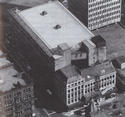 By 1914 the cinema was firmly established in Glasgow. From film's primitive beginnings in the mid-1890s as a fairground "bioscope" entertainment or occasional filler in a variety or music hall bill, the cinema had matured into a thriving entertainment industry in its own right.
By 1914 the cinema was firmly established in Glasgow. From film's primitive beginnings in the mid-1890s as a fairground "bioscope" entertainment or occasional filler in a variety or music hall bill, the cinema had matured into a thriving entertainment industry in its own right.
 "Picture palaces" dedicated exclusively to the showing of films were springing up across the city. The Green family had established a circuit of Picturedromes, the forerunner of what was to become Scotland's leading cinema chain. The First World War halted the cinema building programme, then in the 1920s came the appearance of the "atmospheric" cinemas - exotic places of escapism with imaginative décor reflected by names such as Orient and Toledo. Talking pictures arrived in the city in January 1929 and heralded a new era in the design of comfortable and cavernous "super cinemas", such as George Singleton's circuit of Vogues, able to accommodate the new sound technology.
"Picture palaces" dedicated exclusively to the showing of films were springing up across the city. The Green family had established a circuit of Picturedromes, the forerunner of what was to become Scotland's leading cinema chain. The First World War halted the cinema building programme, then in the 1920s came the appearance of the "atmospheric" cinemas - exotic places of escapism with imaginative décor reflected by names such as Orient and Toledo. Talking pictures arrived in the city in January 1929 and heralded a new era in the design of comfortable and cavernous "super cinemas", such as George Singleton's circuit of Vogues, able to accommodate the new sound technology.
 Cinema attendance reached a peak in this period, film-goers attending two or three times a week with a constantly changing programme on offer. By the outbreak of war in 1939 the city boasted 114 cinemas. Picture-going reached new heights during the war - it was one of the few entertainments not rationed and offered an escape for a few hours from the harsh reality of wartime life. However, in the mid 1950s attendance began to fall due in part to re-location of communities on new housing schemes without easy access to local cinemas and, in part, to the arrival of television, factors that were to usher in the decline of cinema-going as a regular family entertainment.
Cinema attendance reached a peak in this period, film-goers attending two or three times a week with a constantly changing programme on offer. By the outbreak of war in 1939 the city boasted 114 cinemas. Picture-going reached new heights during the war - it was one of the few entertainments not rationed and offered an escape for a few hours from the harsh reality of wartime life. However, in the mid 1950s attendance began to fall due in part to re-location of communities on new housing schemes without easy access to local cinemas and, in part, to the arrival of television, factors that were to usher in the decline of cinema-going as a regular family entertainment.